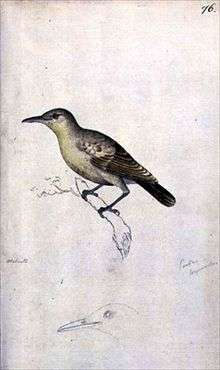Moorea reed warbler
Moorea reed warbler (Acrocephalus longirostris) is a possibly extinct songbird in the genus Acrocephalus. Formerly placed in the "Old World warbler" assemblage (Sylviidae), it is now in the newly recognized marsh warbler family Acrocephalidae. It was once considered a subspecies of the Tahiti reed warbler.
| Moorea reed warbler | |
|---|---|
 | |
| Painting by William Ellis | |
| Scientific classification | |
| Kingdom: | Animalia |
| Phylum: | Chordata |
| Class: | Aves |
| Order: | Passeriformes |
| Family: | Acrocephalidae |
| Genus: | Acrocephalus |
| Species: | A. longirostris |
| Binomial name | |
| Acrocephalus longirostris (J.F. Gmelin, 1789) | |
It was endemic to Moorea in the Society Islands. It had two color morphs; a light morph that was pale yellow with mottled brownish above, and an olive-brown dark morph. It occurred in second-growth-forest as well as Polynesian 'ohe thickets (and likely bred exclusively in the latter) in river valleys and hillsides. It was last seen in 1987, and is presumed to have gone extinct due to habitat destruction by hydroelectric power, road-building, and exploitation of bamboo, as well as the introduction of the invasive species such as the miconia tree, the common myna, and the feral cat. However, two unconfirmed sightings in the 21st century indicate that it may possibly survive in very low numbers.[2] A 2018 study recommended downlisting the species from Critically Endangered (Possibly Extinct) to just Critically Endangered.[3]
Footnotes
- BirdLife International (2016). "Acrocephalus longirostris". IUCN Red List of Threatened Species. 2016: e.T22735588A104321815. doi:10.2305/IUCN.UK.2016-3.RLTS.T22735588A104321815.en.
- "Acrocephalus longirostris (Mo'orea Reed-warbler, Moorea Reed-warbler, Mo'orea Reed Warbler)". IUCN Red List of Threatened Species. Retrieved 2018-01-01.
- Butchart, Stuart H.M.; Lowe, Stephen; Martin, Rob W.; Symes, Andy; Westrip, James R.S.; Wheatley, Hannah (2018-11-01). "Which bird species have gone extinct? A novel quantitative classification approach". Biological Conservation. 227: 9–18. doi:10.1016/j.biocon.2018.08.014. ISSN 0006-3207.
References
